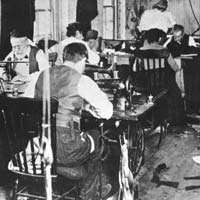Ritchie v. People (1895) & Ritchie v. Wayman (1910)
The Illinois Supreme Court held in Ritchie v. People (1895) that section 5 of the Illinois Factory and Workshop Inspection Statute, limiting to eight the number of hours women could work in factories, was unconstitutional, as violating the Fourteenth Amendment to the United States Constitution. The case was brought by the Illinois Manufacturers’ Association as a direct challenge to the operation of the Office of the Factory Inspector. As soon as the law was enacted, it was challenged. And the parties decided to bring the question of the constitutionality of the statute directly to the Supreme Court of Illinois.
The states’ authority to regulate private commercial enterprises on the justification of protecting the health of women and children was how the issue was framed. The Hearings and Briefs for this case document how women and children worked, and the conditions of the factories as they were found by Florence Kelley, the Chief Factory Inspector, and her staff. These Hearings and the testimony presented constituted the factual record which formed the basis of the appeal to the Supreme Court of Illinois.
The principle established in Ritchie I remained in effect until the United States Supreme Court decided in favor of the National Consumers’ League in the Muller v. Oregon decision, handed down February 24, 1908. At that time Florence Kelley was the Secretary of the National Consumers’ League.
After the United States Supreme Court decision in Muller v. Oregon, Louis Brandeis, the attorney for the National Consumers’ League, argued before the Supreme Court of Illinois in a case challenging the constitutionality of a recently enacted Illinois ten hour statute, modeled exactly upon Oregon law upheld by the United States Supreme Court. That case, Ritchie v. Wayman, 91 N.E. 695 (1910) (Ritchie II) was decided in favor of upholding the constitutionality of the new Illinois ten hour law on April 21, 1910.
Fifteen years after the decision in Ritchie v. People in 1895, the case became a legal nullity, although the 1895 opinion was never explicitly overruled by either the United States Supreme Court or the Supreme Court of Illinois.
Muller v. Oregon (1908)
Muller v. Oregon is the United States Supreme Court case upholding the constitutionality of a state law in Oregon limiting to ten the hours women could work in laundries or mechanical establishments or factories. The case is relevant as a later development of the issues raised in the litigation challenging the constitutionality of the Factory and Workshop Inspection Statute in Illinois.
Muller v. Oregon basically invalidated the principle under which the Illinois Supreme Court held in Ritchie v. People (1895) that section 5 of the Illinois Factory and Workshop Inspection Statute, limiting to eight the number of hours women could work in factories, was unconstitutional, as violating the Fourteenth Amendment to the United States Constitution.
Arguing for the position that the Oregon ten hour law was constitutional was Louis D. Brandeis, pro bono on behalf of the National Consumers League, where Florence Kelley was at the time General Secretary. Between 1895 and 1908 there was considerable law and litigation in both the state and federal courts on the issue of the constitutionality of state and federal wages and hours legislation.
The states’ ability to regulate private commercial enterprises on the justification of protecting the health of women and children was how the issue was framed in Muller v. Oregon, although many other economic and political issues were explicitly and implicitly present in these cases.
Muller v. Oregon was the first case argued before the United States Supreme Court to rely upon what came to be known as a Brandeis Brief. The first Brandeis Brief, submitted to the United States Supreme Court in Muller v. Oregon, consisted of a detailed compendium of facts and legal background, legal history, prepared under a one month deadline by Florence Kelley and Josephine Goldmark, a colleague at the National Consumers’ League and the sister in law of Louis Brandeis.
The first Brandeis Brief was revolutionary for United States Supreme Court practice. After the victory for the National Consumers’ League in the Muller decision, handed down February 24, 1908, Louis Brandeis argued before the Supreme Court of Illinois in a case challenging the constitutionality of a recently enacted ten hour statute, modeled exactly upon Oregon law upheld by the United States Supreme Court. That case, Ritchie v. Wayman, 91 N.E. 695 (1910)(Ritchie II) was decided in favor of upholding the constitutionality of the new Illinois ten hour law on April 21, 1910.
Louis D. Brandeis was appointed Justice of the United States Supreme Court in February of 1916.
Next: Mayors and Aldermen
